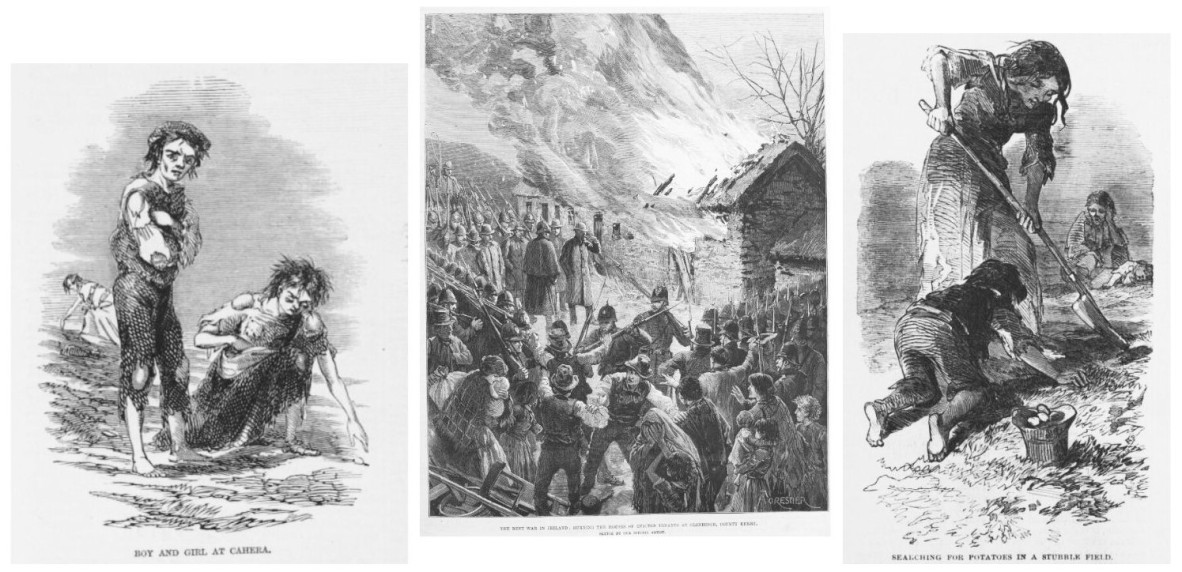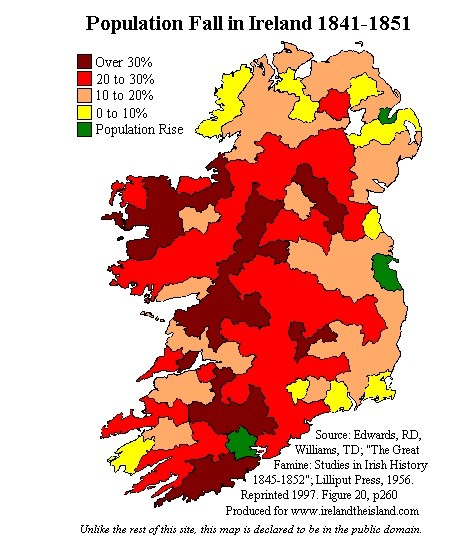Foreshadowing the famine disaster in Ireland: the Devon Commission, an inquiry into the occupation of land in Ireland 1843-1845
By Stephanie Ryan, Research Librarian, Library and Client Services | 23 August 2023
The Devon Commission, chaired by Lord Devon, presented its report on the occupation of land in Ireland in February 1845, a few months before the worst of the famine. The impact of the report lies in the clear evidence that living was so subsistence for the population, mostly tenant farmers, that a major crop failure would ravage the lives of many. The west coast, as the map below indicates, was particularly vulnerable. The Commission said that the main cause of Irish discontent was the poor relations between landlord and tenant. The report discussed the land under a number of headings including ownership, occupation, valuation, subdivision, absentee ownership, rent and middlemen.
While it has been described as a “landlords’ Commission” (The great hunger : Ireland, 1845-9, Woodham-Smith, p. 21) the report is important because:
- it sets the scene for significant issues on the eve of the worst of the famine
- it collected evidence from 1,125 witnesses from all over Ireland
- the minutes of evidence published with the report provide important local detail.
The material in the report is very accessible because of the way it is organised. The Commission heard evidence in various locations, and the material includes a list of places where they sat, and the names of the witnesses who appeared. The chronological arrangement means that the minutes of evidence of witnesses who testified in a particular location are together. Useful indexes provided are:
- minutes of evidence indexed by subject and witnesses’ names
- a list of witnesses organised by county
- witnesses - named, assigned a number with identifying information, including occupation.
A case study in Killorglin County Kerry
A researcher discovered on a death certificate that his immigrant ancestor was born in Reen townland, Killorglin parish, County Kerry. A townland is the smallest geographic unit of land and may have nothing to do with a town. It is helpful to identify an individual or family within this context because of the frequent repetition not only of a surname but also of first names. He wanted to know more about Reen, and why his ancestor might have emigrated.
A first step was to search land records relevant to the period of interest, the Tithe Applotment Books, the first surviving national list of the occupiers of land available and online from the National Archives of Ireland. They were compiled between 1823 and 1837 to determine the amount which occupiers of agricultural holdings over one acre should pay in tithes to the established church of the time, the Church of Ireland.
The tithe records showed the quality of land in Reen. Some occupiers, such as Mary Flynn in Lower Reen, had little arable land and many had less than half their land of good quality.
Titheable
| Townlands | Name of occupiers | Rents paid | Quality | Quantity in detail |
|---|---|---|---|---|
| Lower Reen 145 | Mary Flynn widow | 7.12.3 | Arable | 6.1.36 |
| Embanked marsh | 4.3.17 | |||
| Bad marsh | 4.1.24 | |||
| Lower Reen 146 | John W Houlahon | 46.6.0 | Arable | 20.3.16 |
| Embanked marsh | 22.1.30 | |||
| Bad marsh | 6.1.24 | |||
| Lower Reen 147 | Batholomew Connor | 46.6.0 | Arable | 20.2.37 |
| Embanked marsh | 22.1.30 | |||
| Bad marsh | 4.1.24 | |||
| Lower Reen 148 | Timothy Daley | 46.6.0 | Arable | 18.3.11 |
| Embanked marsh | 22.1.30 | |||
| Bad marsh | 6.1.40 | |||
| Bog | 9.2.35 |
What did this quality of land mean for the tenants?
In order to gain a further understanding of the implications of this land quality and rent and how the occupiers could manage, the following statement given to the Commission from a witness is enlightening.
On the 2nd September 1844 Rev. Eugene O’Sullivan of Killorglin gave evidence to the Devon Commission. He described a large farm where, with one exception,
the condition of the tenantry on that land is very deplorable…. It is the worst description of bog that I know of in this country - the red bog, which the labourers consider to be of the worst description. There is, convenient to this bog, a sand-bank and they get sea-weed convenient to it; and they are obliged, in order to reclaim this bog, in many instances to draw the sand upon their backs – I do not know the exact distance; I suppose, at least, an English mile or more, perhaps an Irish mile in some cases, in some cases two English miles; and by extraordinary efforts and in some instances, by wasting their own constitutions, they have rescued this very barren farm – at least, they have improved it very much, and made it capable of producing potato crops. Oats, it is not able to produce, except in very rare instances; and after they have, by these efforts upon their part, made it capable of producing crops of that description, the landlord, about two years ago, and his agent, came upon the farm and examined the improvements and then doubled the rent upon the tenants, in place of giving them any compensation or recompense for their trouble.
- Rev. Eugene O’Sullivan (witness 682), Devon Commission, p 881
It was clear that in a country that already suffered periodic food shortages to the serious detriment of the population, the famine of 1845-1849 would cause dramatic problems. The tenants of Reen, whose rent had doubled, would now be starving and they were not the worst affected on the west coast of Ireland. Massive depopulation through death or migration followed. Approximately a million people died and another two million migrated.

Illustrated London News l-r: 20 February 1847 p116; The rent war in Ireland: burning the houses of evicted tenants at Glenbeigh, County Kerry 29 January 1887 p111; 20 February 1847 p116
Famine conditions varied from one part of Ireland to another, and this is where the Devon Commission can shine a light on the local conditions of ‘The Great Hunger’ and why some Irish came to Australia.
The rent war flourished as bare subsistence continued. From 1879 yet another agricultural disaster obstructed recovery after the famine. The Land League was formed to campaign for the permanent reduction of rents, to stop evictions for nonpayment of rents, and for laws to allow every tenant to own his holding.
Find out more:
- Attend the free webinar Find your Irish family history
- Become a member to access online databases
- State Library catalogue, One Search for Irish famine
Check:
- the section of the Devon Commission relevant to your interest
- the Illustrated London news and read its reports on the Irish famine which illuminate the sketches of horror and tenant ejectment.
- the Irish newspaper archive with its county newspapers
More information
Family history month https://www.slq.qld.gov.au/familyhistorymonth
One Search catalogue – https://onesearch.slq.qld.gov.auopen_in_newopen_in_new
-
Library membership – https://www.slq.qld.gov.au/services/membership
-
Plan your visit – https://www.slq.qld.gov.au/visit
Ask a librarian - https://www.slq.qld.gov.au/services/ask-librarian
Comments
Your email address will not be published.
We welcome relevant, respectful comments.
